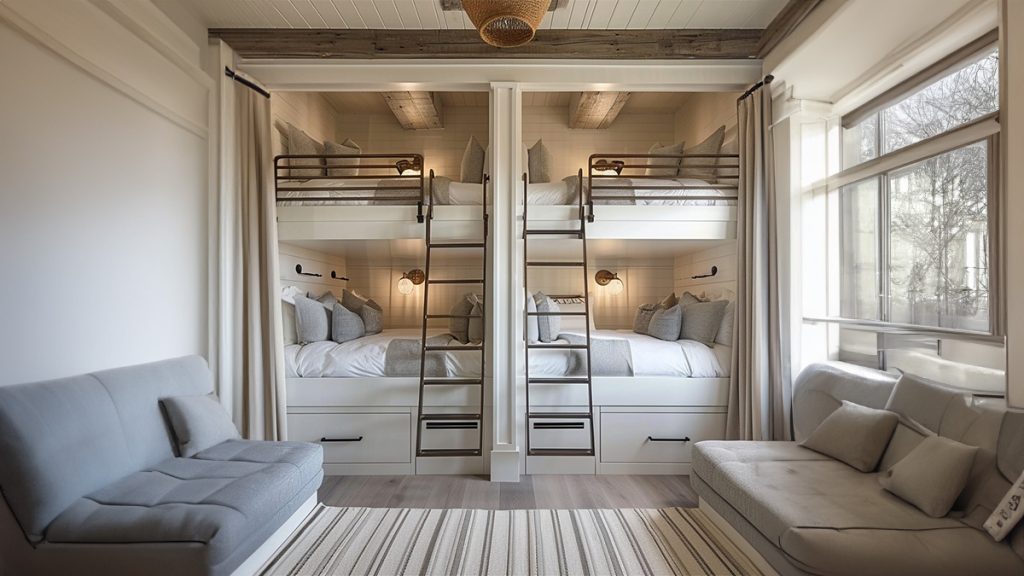Creating the ultimate bunk room is an exciting challenge that combines functionality, safety, and creative flair. Whether for kids’ sleepovers, family gatherings, or maximizing space in vacation homes, a well-designed bunk room can provide comfortable and stylish sleeping arrangements. Here’s how top designers recommend building the ultimate bunk room.
1. Prioritize Safety and Functionality
Safety should be your top priority, especially in kids’ bunk rooms.
- Sturdy Construction: Ensure the bunk beds are solidly constructed and can support the weight they’ll need to hold.
- Guard Rails and Ladders: Install guard rails on the upper bunks and secure, easy-to-climb ladders to prevent falls.
- Accessible Light Sources: Each bunk should have its own light source, like a small, attachable reading lamp, easily accessible to the occupant.
2. Maximize Space with Smart Design
Bunk rooms are often about maximizing space without sacrificing comfort.
- Built-In Storage: Incorporate built-in storage under the lower bunks or in the stairs for efficient use of space.
- Space-Saving Furniture: Opt for space-saving furniture like foldable desks or wall-mounted shelves to keep the room uncluttered.
3. Comfort is Key
Comfortable bedding and mattresses are essential for a good night’s sleep.
- Quality Mattresses: Invest in good-quality, durable mattresses that provide proper support.
- Cozy Bedding: Choose soft, inviting bedding with fun patterns or colors to add warmth and personality to the room.
4. Personalize with Creative Themes
A theme can make a bunk room more inviting and exciting.
- Thematic Decor: Consider themes like nautical, adventure, or whimsical fairy tales to spark imagination and joy.
- Customizable Elements: Allow for personalization with items like nameplates on each bunk or a small bulletin board for photos and drawings.
5. Consider the Age Group
Design the bunk room to suit the age group of its primary users.
- For Younger Kids: Incorporate playful elements, bright colors, and safety features like nightlights and rounded corners.
- For Teens and Adults: Opt for a more sophisticated color palette and provide individual charging stations and privacy curtains.
6. Utilize Color and Lighting for Ambiance
The right color scheme and lighting can transform the atmosphere of a bunk room.
- Soothing Colors: Use calming colors for
walls and bedding to create a relaxing environment.
- Layered Lighting: Implement a combination of overhead, task, and accent lighting to cater to different needs and moods.
7. Flexible and Adaptable Design
A bunk room should be able to evolve with changing needs.
- Modular Furniture: Consider modular bunk beds that can be separated or reconfigured.
- Multipurpose Space: Design the room to serve multiple purposes, like doubling as a study or play area when not used for sleeping.
8. Involve the Users in the Design Process
Involving the users, especially children, in the design process can make the space more meaningful and enjoyable for them.
- Choice of Themes: Let them have a say in choosing the room’s theme or color scheme.
- Personal Touches: Encourage them to decorate their own bunk area with their favorite items or artwork.
Conclusion: A Dream Bunk Room Awaits
Building the ultimate bunk room is about blending practicality with creativity. By focusing on safety, functionality, comfort, and personalization, you can create a space that is not only efficient but also a source of joy and fond memories. Remember, the best bunk room is one that meets its users’ needs while sparking their imagination.
